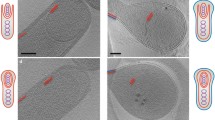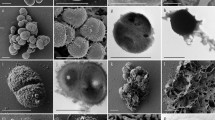Abstract
Thermosipho globiformans is a member of Thermotogales, which contains rod-shaped, Gram-negative, anaerobic (hyper)thermophiles. These bacteria are characterized by an outer sheath-like envelope, the toga, which includes the outer membrane and an amorphous layer, and forms large periplasm at the poles of each rod. The cytoplasmic membrane and its contents are called “cell”, and the toga and its contents “rod”, to distinguish between them. Optical cells were constructed to observe binary fission of T. globiformans. High-temperature microscopy of rods adhering to optical cells' coverslips showed that the large periplasm forms between newly divided cells in a rod, followed by rod fission at the middle of the periplasm, which was accompanied by a sideward motion of the newly generated rod pole(s). Electron microscopic observations revealed that sessile rods grown on a glass plate have nanotubes adhered to the glass, and these may be involved in the sideward motion. Epifluorescence microscopy with a membrane-staining dye suggested that formation of the septal outer membrane is distinct from cytokinesis. Transmission electron microscopy indicated that the amorphous layer forms in the periplasm between already-divided cells. These findings suggest that the large periplasm is the structure in which the septal toga forms, an event separate from cytokinesis.





Similar content being viewed by others
Abbreviations
- ATOC:
-
Anaerobic thermophile observation chamber
- FE-SEM:
-
Field-emission scanning electron microscopy
- HTM:
-
High-temperature microscopy
- OM:
-
Outer membrane
- TEM:
-
Transmission electron microscopy
References
Adams DW, Errington J (2009) Bacterial cell division: assembly, maintenance and disassembly of the Z ring. Nat Rev Microbiol 7:642–653
Andrews KT, Patel BKC (1996) Fervidobacterium gondwanense sp. nov., a new thermophilic anaerobic bacterium isolated from nonvolcanically heated geothermal waters of the Great Artesian Basin of Australia. Int J Syst Bacteriol 46:265–269
Berlatzky IA, Rouvinski A, Ben-Yehuda S (2008) Spatial organization of a replicating bacterial chromosome. Proc Natl Acad Sci USA 105:14136–14140
Deguchi S, Tsujii K (2002) Flow cell for in situ optical microscopy in water at high temperatures and pressures up to supercritical state. Rev Sci Instrum 73:3938–3941
Dubey GP, Ben-Yehuda S (2011) Intercellular nanotubes mediate bacterial communication. Cell 144:590–600
Gluch MF, Typke D, Baumeister W (1995) Motility and thermotactic responses of Thermotoga maritima. J Bacteriol 177:5473–5479
Gorby YA, Yanina S, McLean JS, Rosso KM, Moyles D, Dohnalkova A, Beveridge TJ, Chang IS, Kim BH, Kim KS, Culley DE, Reed SB, Romine MF, Saffarini DA, Hill EA, Shi L, Elias DA, Kennedy DW, Pinchuk G, Watanabe K, Ishii Si, Logan B, Nealson KH, Fredrickson JK (2006) Electrically conductive bacterial nanowires produced by Shewanella oneidensis strain MR-1 and other microorganisms. Proc Natl Acad Sci USA 103:11358–11363
Horn C, Paulmann B, Kerlen G, Junker N, Huber H (1999) In vivo observation of cell division of anaerobic hyperthermophiles by using a high-intensity dark-field microscope. J Bacteriol 181:5114–5118
Huber R, Stetter KO (1992) The order Thermotogales. In: Balows A, Trüper HG, Dworkin M, Harder W, Schleifer KH (eds) The Prokaryotes. Springer, New York, pp 3809–3815
Huber R, Langworthy TA, König H, Thomm M, Woese CR, Sleytr UB, Stetter KO (1986) Thermotoga maritima sp. nov. represents a new genus of unique extremely thermophilic eubacteria growing up to 90 °C. Arch Microbiol 144:324–333
Kuwabara T, Minaba M, Iwayama Y, Inouye I, Nakashima M, Marumo K, Maruyama A, Sugai A, Itoh T, Ishibashi J, Urabe T, Kamekura M (2005) Thermococcus coalescens sp. nov., a cell-fusing hyperthermophilic archaeon from Suiyo Seamount. Int J Syst Evol Microbiol 55:2507–2514
Kuwabara T, Kawasaki A, Uda I, Sugai A (2011) Thermosipho globiformans sp. nov., an anaerobic thermophilic bacterium that transforms into multicellular spheroids with a defect in peptidoglycan formation. Int J Syst Evol Microbiol 61:1622–1627
L’Haridon S, Miroshnichenko ML, Hippe H, Fardeau M-L, Bonch-Osmolovskaya E, Stackebrandt E, Jeanthon C (2001) Thermosipho geolei sp. nov., a thermophilic bacterium isolated from a continental petroleum reservoir in Western Siberia. Int J Syst Evol Microbiol 51:1327–1334
Margolin W (2005) FtsZ and the division of prokaryotic cells and organelles. Nat Rev Mol Cell Biol 6:862–871
Miranda-Tello E, Fardeau M-L, Thomas P, Ramirez F, Casalot L, Cayol J-L, Garcia J-L, Ollivier B (2004) Petrotoga mexicana sp. nov., a novel thermophilic, anaerobic and xylanolytic bacterium isolated from an oil-producing well in the Gulf of Mexico. Int J Syst Evol Microbiol 54:169–174
Reynolds ES (1963) The use of lead citrate at high pH as an electron-opaque stain in electron microscopy. J Cell Biol 74:208–212
Weiss DS (2004) Bacterial cell division and the septal ring. Mol Microbiol 54:588–597
Wery N, Lesongeur F, Pignet P, Derennes V, Cambon-Bonavita M-A, Godfroy A, Barbier G (2001) Marinitoga camini gen. nov., sp. nov., a rod-shaped bacterium belonging to the order Thermotogales, isolated from a deep-sea hydrothermal vent. Int J Syst Evol Microbiol 51:495–504
Woese CR, Kandler O, Wheelis ML (1990) Towards a natural system of organisms: proposal for the domains Archaea, Bacteria, and Eucarya. Proc Natl Acad Sci USA 87:4576–4579
Yoshida M, Noël M-H, Nakayama T, Naganuma T, Inouye I (2006) A haptophyte bearing siliceous scales: ultrastructure and phylogenetic position of Hyalolithus neolepis gen. et sp. nov. (Prymnesiophyceae, Haptophyta). Protists 157:213–234
Acknowledgments
We thank Drs. Shigeru Deguchi and Sada-atsu Mukai of the Japan Agency for Marine-Earth Science and Technology for microscopic observations using their HTM system during the initial stages of this study, and Dr. Haruyo Yamaguchi for helping us with electron microscopy techniques. We are also grateful to Mr. Akitomo Kawasaki for some TEM work.
Author information
Authors and Affiliations
Corresponding author
Additional information
Communicated by S. Albers.
Electronic supplementary material
Below is the link to the electronic supplementary material.
Supplementary material 2: Movie S2 (MPG 1647 kb)
Supplementary material 3: Movie S1 (MPG 4586 kb)
Rights and permissions
About this article
Cite this article
Kuwabara, T., Igarashi, K. Microscopic studies on Thermosipho globiformans implicate a role of the large periplasm of Thermotogales. Extremophiles 16, 863–870 (2012). https://doi.org/10.1007/s00792-012-0481-9
Received:
Accepted:
Published:
Issue Date:
DOI: https://doi.org/10.1007/s00792-012-0481-9




